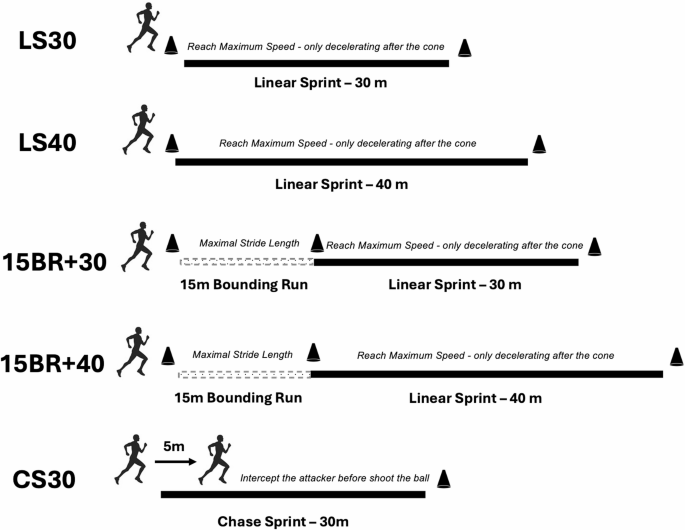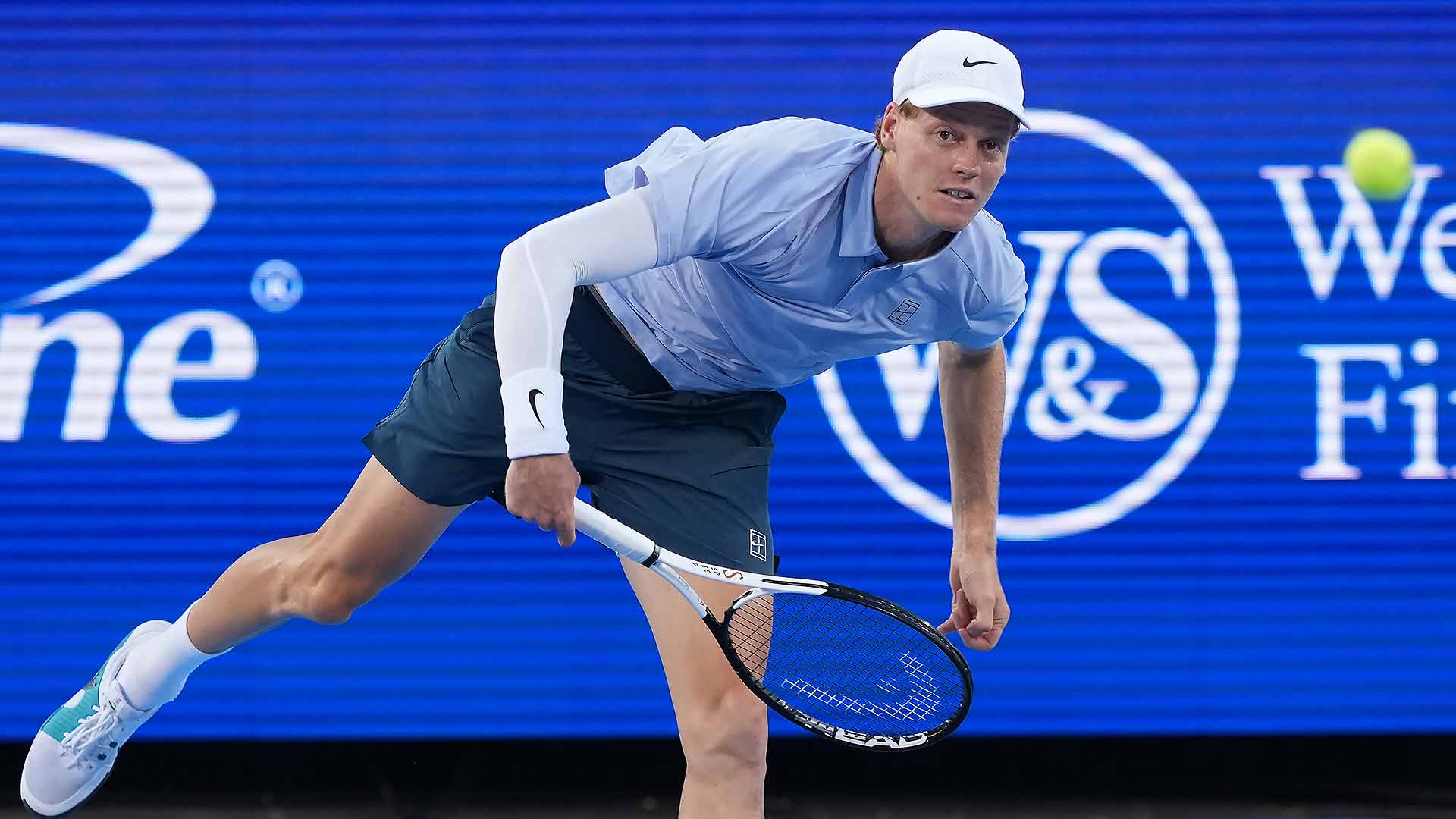The speed dynamics of different sprint and acceleration exercises applied during football training

This study examined different sprint drills in relation to the distances covered at various percentages of maximum speed, assessed using GPS data, among under-19 and under-23 Portuguese National Championship football players. The main findings were: (i) 15BR + 30LS (Fig. 2C) drill differed from all other conditions in HSR1 (between 55 and 65% of maximum speed), achieving higher values in this metric; (ii) 15BR + 30LS (Fig. 2C) drill was different from all other sprint drills, recording the lowest ACC value; (iii) LS40 (Fig. 2-B) drill showed significant differences in Sprint3 (> 95% of maximum speed) compared to all other sprint drills. These results provide valuable insights for coaches and practitioners aiming to optimize sprint training in football, as different drills elicit distinct speed and acceleration profiles. The LS40 (Fig. 2-B) and CS30 drills (Fig. 2-E) were found to be the most effective for achieving higher sprint and acceleration intensity, respectively.Sprinting in football is a highly relevant high-intensity movement, as it is related to decisive actions during the game28,29, players often initiate those movements with some initial speed, rather than starting from a stationary position30. Therefore, flying sprints seem to be more specific to match-related demands. In this scenario, drills incorporating bounding runs as a form of flying start may be more representative of the game profile. Moreover, it was also expected that a higher initial speed would position the players closer to their peak speed, thereby favoring a greater accumulation of distance under very high-speed conditions. However, the present results indicate that they are not effective (especially 15BR + 30LS, Fig. 2-C) in providing sprint speed stimulus above 95% of peak speed (Sprint3 threshold) and higher maximal accelerations values. Therefore, our findings suggest that the constraints imposed by the tasks (initiating with a bounding run) may alter the mechanical pattern of running compared to a stationary start, allowing the player to accumulate greater distances in HSR zones when compared to sprinting. Regarding the acceleration, the lower values could be probably related to the high initial speed value before the linear sprint action19 reducing the ability to accelerate at higher speeds30,31. Furthermore, there is an inverse relationship between running speed and foot contact times32,33,34. The decreased contact time at higher speeds limits the impulse generated by the lower limb. Conversely, when accelerating from a stationary position, the longer time available for applying force results in greater acceleration values. This rationale is supported by a significant, near-perfect correlation (r= -0.98) between maximal voluntary acceleration and initial running speed35. However, as a consequence of higher intensities required to achieve peak speed from a stationary start, significant levels of fatigue may interfere with the microcycle organization, which must ensure the highest readiness level on game day. Therefore, research has shown that flying sprints are a superior method to achieve higher sprint speeds when compared to a stationary start36, as they remove the vigorous acceleration component of the latter, which is believed to have a significant energetic cost associated with it19,37. Consequently, this method could be used as an approach to minimize fatigue accumulation without compromising important muscular and performance adaptations. However, to attain peak speeds using this method, prolonging the sprinting distance could be necessary, leading to an increased external load at high speeds.Despite the observed differences between the drills, all conditions enabled the athletes to reach the Sprint2 intensity (90–95% maximal speed), which was previously found to be related to increased myoelectric activity of the hamstrings during the swing phase of running, in track-and-field athletes38,39. When considering the results of this study, one can expect all drills to be effective in adequately stimulating the hamstrings complex since the athletes reached at least 95% of their maximum capacity. It is believed that sprinting at proper intensities likely induces tissue healing and repair, which may aid athletes during their rehabilitation process40, and should be considered as an important criterion for defining an adequate dosage of a “vaccine” aimed at preventing hamstring injuries. Although musculoskeletal injuries have a multifactorial profile, it has been suggested that this level of intensity has possibly been linked elsewhere to a lower risk of lower limb injury. Consequently, this approach to exercise prescription may prevent athletes from being exposed to sufficient sprint intensities, and the relationship between the risk of injury and the exposure to other types of sprints intensities should be addressed in future studies. Therefore, these findings highlight the need for further investigation.Considering the present results and data from previous studies, if we aim to expose players to the highest intensity, we should provide at least 40-m linear distances when starting from a stationary position, and more than 40-m if preceded by a rolling start. It would be interesting to assess exactly what distance should be provided to the athletes when they perform flying sprints and if reducing the flying sprint distance might allow for higher early acceleration capacity, thereby enabling them to achieve the Sprint3 zone earlier. However, if acceleration is the focus of development, we advocate the use of CS30 (Fig. 2-E), as it presents the highest acceleration value of all drills. A plausible explanation is the visual feedback that the player receives, knowing they are positioned 5 m behind the player they are attempting to dispossess. This anticipatory response may elicit a more pronounced acceleration, as the athlete must quickly close the distance to execute the defensive maneuver effectively. The spatial and temporal constraints inherent in this drill likely contribute to the heightened acceleration values recorded.This study has some limitations. Firstly, it is possible to verify that before the first 10 s of the run, the athletes do not start from a completely stationary position. This is likely due to the GPS device being positioned on the torso, making it challenging to avoid detecting such variations, especially during the athlete’s initial movement when leaning forward before starting. Moreover, the limitations of GPS in identifying initial speed and acceleration must be taken into account, as the data is processed as a single instantaneous speed every 0.1 s, which increases the complexity of accurately identifying the moment of ‘cut-off’. However, the study’s goal is not to analyze absolute values, but rather to evaluate the curve of each sprint drill and compare the different exercise intensities. Therefore, this analysis takes into account and eliminates this potential effect. Secondly, it is only performed with linear sprints, and therefore the present results cannot be transferred to non-linear sprints. Thirdly, it should be considered that in the 15 m bounding drills, different stride patterns may lead to varying starting speeds after the 15 m mark. However, feedback was given to the players to achieve the longest possible stride up to the 15 m cone, and restricting the stride in the first 15 m would alter the running technique of the players, as the goal of the study was not to compare players but to analyze the drills. Finally, we cannot rule out a possible effect of accumulated fatigue due to games and training sessions, although the test sessions were randomized, standardized for the same day of the week, and conducted at the beginning of the training session with the drill.













